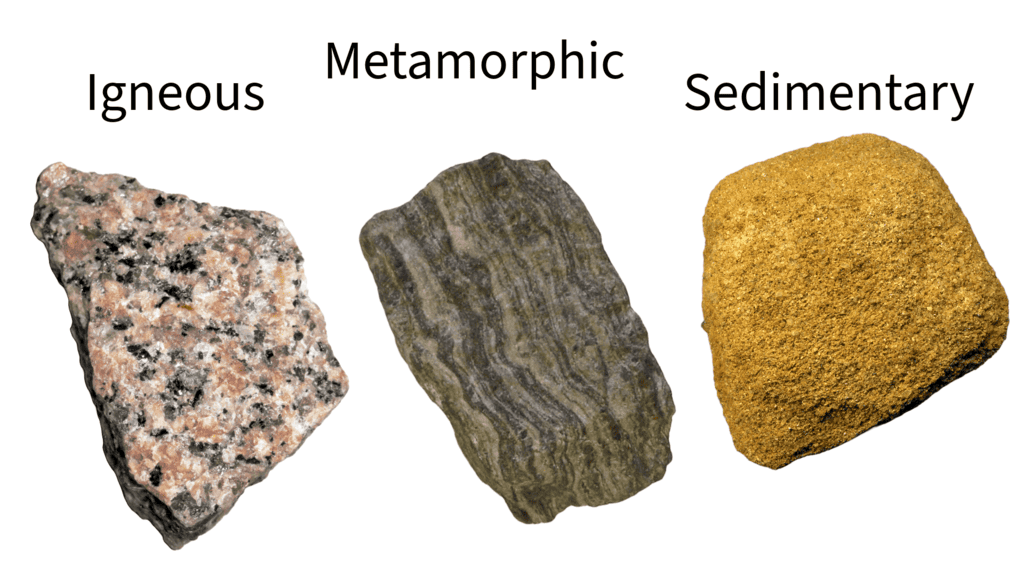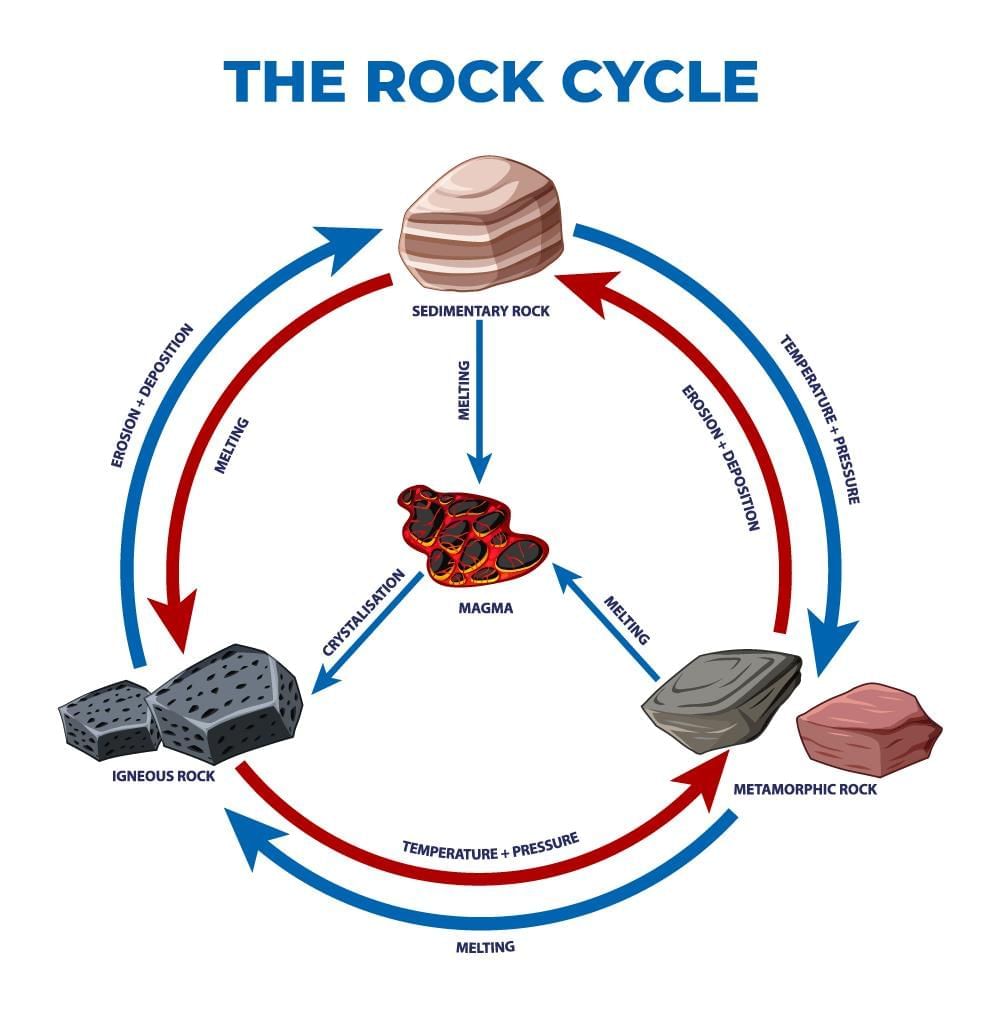Rocks Chapter Notes | Science for Grade 4 PDF Download
| Table of contents |

|
| Rocks |

|
| Types of Rocks |

|
| Rock Cycle |

|
| Economic Importance of Rocks |

|
Ever wondered what lies beneath the Earth's surface? The chapter "Rocks" in ICSE Class 9 Geography takes you on an exciting journey to explore the solid foundation of our planet. Rocks are not just lifeless stones; they are the storytellers of Earth's history, holding clues to ancient environments and processes. From fiery igneous rocks born from molten magma to layered sedimentary rocks preserving fossils, and metamorphic rocks transformed by heat and pressure, this chapter unveils the fascinating world of rocks and their role in shaping the Earth's crust. Get ready to discover how rocks cycle through time and their importance in our lives!
Rocks
- Earth's crust is composed of various types of rocks.
- Rocks are essential for soil formation through weathering and decomposition.
- Rocks contain a variety of minerals.

Differences Between Rocks and Minerals
- Rocks are solid materials that may consist of multiple minerals.
- Minerals are naturally occurring inorganic substances.
- Rocks lack a definite chemical composition.
- Minerals have a specific chemical composition.
- Rocks are classified into igneous, sedimentary, and metamorphic types.
- Minerals are grouped into silicates, carbonates, sulphides, and metallic minerals.
- Examples of rocks include marble, slate, and limestone.
- Examples of minerals include iron, aluminium, and calcium.
Types of Rocks
- Rocks are divided into three main types based on their origin: igneous, sedimentary, and metamorphic.
Igneous Rocks
- Known as primary rocks, they form the basis for other rock types.
- Formed by cooling, solidification, and crystallization of molten magma.
- Mainly contain alumino-silicate minerals like quartz and feldspar.
Characteristics:
- Hard and resistant to erosion.
- Can be fine-grained, smooth, and compact or have large crystals with coarse texture.
- Water seeps through cracks and joints, making them less affected by chemical weathering.
- Subject to mechanical weathering.
- Associated with volcanic activities, commonly found in volcanic regions.
Types of Igneous Rocks:
Extrusive Igneous Rocks:
- Formed when molten magma cools on Earth's surface through cracks, fissures, or volcanic eruptions.
- Also called volcanic rocks, they are smooth, crystalline, and fine-grained due to rapid cooling.
Example: Basalt, commonly found in volcanic regions like the Deccan Plateau in India.
Intrusive Igneous Rocks:
- Formed when magma cools and solidifies beneath Earth's surface.
- Have coarse texture with large crystals due to slow cooling.
Examples: Dolomite and granite.
Types include:
- Batholiths: Dome-shaped structures formed by magma cooling below the surface, exposed by erosion.
- Laccoliths: Magma solidifies just below the crust, forming dome-shaped upper layers with a flat bottom.
- Sills: Horizontal layers formed when magma solidifies between rock layers.
- Dykes: Vertical or slanting structures formed when magma solidifies in cracks and fissures.
- Necks: Solidified magma in the passage of an extinct volcano, also called volcanic plugs.
Classification Based on Chemical Composition:
- Acid Igneous Rocks: Contain 65%–85% silica, low in iron and magnesium, light in color (e.g., granite).
- Basic Igneous Rocks: Heavy and dark in color (e.g., basalt).
Sedimentary Rocks
- Formed from fragments of igneous rocks broken down by weathering, transported, and deposited by agents like water, glaciers, and ocean waves.
- Lithification turns loose sediments into solid rocks.
Characteristics:
- Known as secondary rocks, formed from sediments of other rocks.
- Cover 75% of Earth's surface.
- Non-crystalline, soft, and layered due to sediment deposition.
- May contain plant and animal remains between layers.
- Subdivided based on sediment nature, origin, and composition.
Classification of Sedimentary Rocks:
Based on Processes:
- Evaporation: Water evaporates, leaving chemical deposits that compact and cement to form rocks.
- Compaction: Loose sediments harden under pressure from overlying and underlying rocks (e.g., sandstone from compacted sand).
- Cementation: Compacted sediments bind together with natural materials like silica or iron.
Based on Formation:
- Mechanically Formed Rocks: Formed from fragments of old rocks deposited by water or glaciers.
- Chemically Formed Rocks: Formed by chemical sedimentation, often due to evaporation of salt-containing water.
- Organically Formed Rocks: Formed from compressed plant and animal remains (e.g., limestone, lignite).
Based on the Agent of Formation:
- Riverine Rocks: Formed by deposition of alluvial soil by streams.
- Lacustrine Rocks: Formed on lake beds after long-term deposition.
- Glacial Rocks: Formed from debris deposited by glaciers.
- Aeolian Rocks: Formed by cementation of wind-blown sand particles.
Marine Rocks:
- Calcareous Marine Rocks: Formed from shells and skeletons of sea organisms.
- Carbonaceous Rocks: Formed from buried sea plants and animals over long periods.
Metamorphic Rocks
- Formed when existing rocks are transformed by high temperature and pressure.
- Metamorphism is the process of forming these rocks.
Types of Metamorphism:
- Thermal Metamorphism: Caused by extreme heat from magma or friction between moving rocks (e.g., slate formed from clay).
- Dynamic Metamorphism: Occurs due to large-scale crustal movements, pushing rocks deeper to form new rocks (e.g., shale to hornfels).
- Regional Metamorphism: Caused by large-scale changes like mountain building, forming new rocks from buried igneous or sedimentary rocks.
- Local/Contact Metamorphism: Affects a small area (e.g., sandstone to quartzite).
Processes of Metamorphism:
- Mechanical Metamorphism: Changes rock texture through crushing and rubbing (e.g., shales to slaty splits).
- Chemical Recombination: Rocks with multiple minerals transform into a single rock.
- Chemical Replacement: Liquids and gases entering rocks through cracks cause chemical changes, forming new rocks.
- Recrystallisation: Minerals in rocks form larger crystals before metamorphism.
Example of Metamorphism: When limestone, a sedimentary rock, is subjected to high heat and pressure, it transforms into marble, a metamorphic rock. This process, called recrystallization, changes the mineral structure, making marble harder and more crystalline, often used in sculptures and buildings.
Rock Cycle
- The rock cycle is the continuous transformation of rocks from one type to another.
- Processes:
- Hot lava cools to form igneous rocks.
- Igneous rocks break into small particles, which are transported and deposited to form sedimentary rocks.
- Igneous and sedimentary rocks under heat and pressure transform into metamorphic rocks.
- Metamorphic rocks break down under heat and pressure to form hot magma.
- Magma cools to form igneous rocks, restarting the cycle.

Economic Importance of Rocks
- Rocks have been crucial for human civilization.
- Early humans used rocks like quartzite to make tools.
- Rocks are used in construction (e.g., red sandstone in Red Fort, white marble in Taj Mahal).
- Small stones are used in games.
- Rocks like granite are used in building construction.
- Rocks contain valuable minerals like coal, petroleum, iron, gold, and aluminium for industries.
- Sedimentary rocks contain fossils, a significant energy source.
|
25 videos|44 docs|24 tests
|















